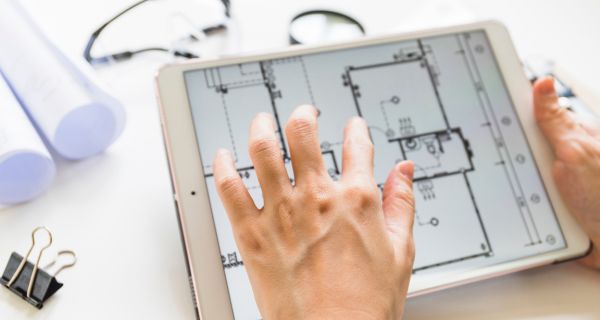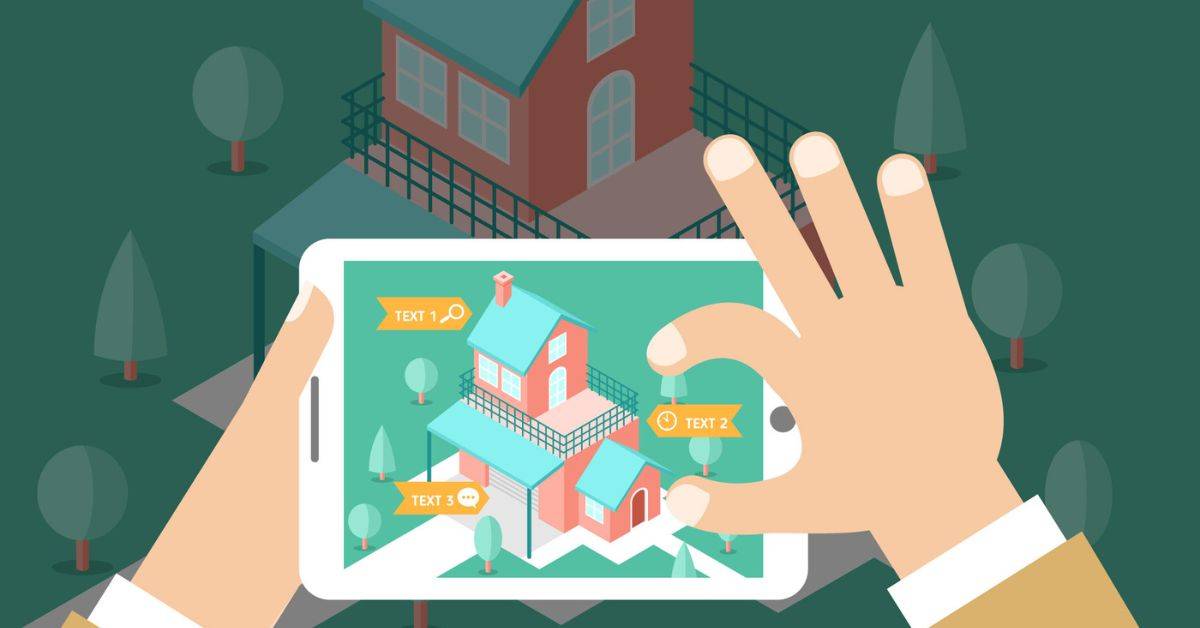With the rising popularity of Augmented Reality, its usage in different sectors is growing. Construction is one such sector that utilizes Augmented Reality very efficiently. Augmented Reality in construction finds application across marketing, training, design & prototyping, and several others.
In Simple terms, AR uses camera-based sensors, GPS coordinates, and other inputs to create project visualizations in near real-time. In construction, it can, thus, give you an accurate representation of how your actual construction site will look when complete.
How is Augmented Reality used in construction?
Augmented Reality is a technology that allows users to see and interact with virtual objects using their camera devices. In construction, AR is used to help visualize the various stages of a project, from initial planning through completion.
Construction companies use augmented reality applications in order to improve productivity and efficiency during the planning process by making it easier for workers to see in an AR view what they need to do in real life. For example, you are working on an apartment building renovation project where your client wants to install new flooring. Then there are many AR construction applications that allow the teams to create the proposed project or actual project virtually in near-real time using AR to show how it would look once done to the clients.
It can help stakeholders to see what a finished building will look like before being built. AR also allows for the easy sharing of digital models with clients and contractors so that they are able to visualize what the completed building will look like at every stage of construction.
Augmented Reality in construction has also been used extensively as part of the planning and scheduling process by helping engineers visualize how their designs will impact surrounding areas such as utility lines, traffic flow, parking needs, etc., which can all affect cost savings or delays the line if not planned properly the first time around!
The Benefits Of Augmented Reality In Construction
The application of augmented reality in construction benefits the sector overall in various ways:
1. Site Planning And Design

You can use AR as an aid during site planning and design. For example, if you need to know where pipes are located on your property line before digging anything up there, then Augmented Reality can be helpful. You could also use this method if someone wants their house built somewhere else than where they live now – maybe they have enough money saved up already and want a bigger house.
Using AR, contractors can digitize the site — such as providing access codes for doors or gateways from remote locations if needed during installation/construction phases of projects (or even after). This way there are no delays due simply because someone forgot something important! Some companies have even made their own augmented reality construction app for better efficiency and consultants.
2. Live Monitoring And Streamlining QA
AR can be used to monitor and streamline quality assurance. It can also be used to coordinate feedback from different stakeholders, monitor progress, identify issues, and streamline the QA process.
For example – You can use Google Glasses or Microsoft’s HoloLens and integrate it with apps like TaskRabbit to automate capturing images of what project your team is working on. It will help you monitor and make sure the team is working on the right project. This way they’ll know where they’re supposed to be without having someone else take over their job.
3. Maximizing Efficiency And Reducing Costs
Augmented Reality in construction can be used to reduce the costs of construction, by providing workers with information that allows them to complete tasks more efficiently. For example, you could use AR to show your workers how much material it would take for a particular job or how many bricks are required for an entire wall.
This will allow them to make better decisions about what materials they need and how much time and money they need in order to complete this project. This will also help improve efficiency as well as a reduction in overall costs.
4. Enhance Employee Training And Collaboration
One of the most common uses of augmented reality used in construction is for on-site training, where an instructor can show you how to perform a task using your own device. For example, if you’re learning how to use a certain piece of equipment at work or at home, an instructor could walk through each step while showing you what they’re doing in real-time.
This can also be used with construction sites where instructions from managers or coworkers who aren’t physically present —they’ll simply need information about where something needs fixing or other instructions from their coworkers in order for it all to come together smoothly!
5. Improving Customer Engagement And Job Site Security
Augmented reality is used in building construction to improve customer engagement, job site security, and productivity. Augmented reality can help customers see what their space will look like before they move in. It can also help them see how their space will be used after the construction has been completed.
This information can be displayed on a tablet or smartphone screen. You can use this tool to help you visualize how your project will look when it’s under process or finished, or even before it begins. By using an app like Google Earth, you can see how your building will fit into its environment and what kind of impact it will have on nearby landmarks.
Powerful Use Cases Of Augmented Reality In Construction
1. GAMMA AR
Using augmented reality in building, the GAMMA AR software superimposes 3D BIM models on the construction site. It enables you to find flaws before the building is built, minimizing errors and needless back and forth between parties.
Prior to construction, it can be used to visualize models and plans. It is a great way to present and share construction models because it enables all parties to communicate effectively, make wiser decisions, and avoid mistakes.
2. AR Akular
The user’s physical surroundings are enhanced with 3D models thanks to Akular. By utilizing merely a phone or tablet, users of this mobile app can do walkthroughs of 3D models in the physical world. Simply download the software, upload a 3D model, and use your device to watch it come to life.
For businesses who want to display stakeholder’s life-sized 3D models of a building, Akular provides a fantastic solution. Additionally, Akular gives you the option to downsize the model to accommodate a small space if you require it to fit into a dwelling or other area.
3. Arvizio
Arvizio is an enterprise AR and MR solution provider. The capabilities of Arvizio open the door for a wide range of use cases, such as design reviews, spatial data management, marketing demos, QA inspections, on-site model alignment, and more.
Additionally, stakeholders can conduct fully synchronized MR and AR collaborative sessions using its multi-user, multi-location, and real-time capabilities. This keeps everyone on the same page whether they are using a mobile MR device or an MR headset.
4. The Wild
The Wild is a tool for team collaboration that facilitates AR and VR collaboration. With The Wild’s support for Revit and BIM 360, you can gather your entire team in a virtual workspace where you may study designs, make annotations, and coordinate geographically.
The Wild enables users to collaborate from any location and is compatible with PC, mobile, and VR headsets. Teams can expedite design reviews and maintain alignment throughout the process without being in the same room.
5. ICT
The AR software company Innovative Construction Technology (ICT) assists general and specialty contractors in streamlining project installation tracking and reporting. ICT Tracker is a production app that digitizes data collection on iPads in the field and is model-based and simple to use. For the benefit of the entire project team, it provides thorough data right away in reports that are simple to understand. The necessity for manual monitoring or takeoff is eliminated when contractors compare BIM or 3D models to existing installations.
ICT Tracker, as opposed to scanning or 3D photos, collects extensive real-time data to comprehend the progress of the installation and to spot scheduling, production, and expense difficulties to stop margin slip.
The Future Of AR In Construction
Augmented reality in construction sites is becoming more and more popular. In fact, many developers predict that AR will be used in all aspects of construction by 2025. The following are the reasons why:
- The design phase has been around for a while now—but AR technology in construction can make it easier to visualize ideas on the computer screen before building them.
- The planning phase involves creating blueprints and plans for the project so that people involved with the building process know what needs to be done when work starts on site.
- Through the project life cycles of design, bidding, finance, procurement, construction, operations, asset management, and business model change, AI in the construction industry has the ability to assist participants to achieve value.
- Construction gets benefits from Augmented reality in tackling some difficult problems. They are – safety concerns, labor shortages, and cost and schedule overruns.
As we have seen, ar in construction has a lot of benefits. Besides improving efficiency and safety in construction, it is also a great way to reduce costs, improve collaboration and communication, and provide an overall better experience for all parties involved. If you plan to add ar in the construction stages and yet not spend huge amounts on development and maintenance, no-code platforms like ourselves could be the best choice. Sign up now on PlugXR or book a free demo to stay ahead of the curve, competing with the best of construction businesses using augmented reality and other cutting-edge technologies.

